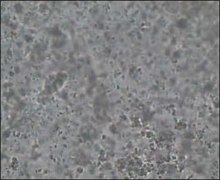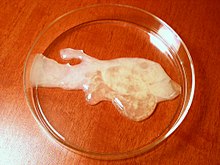Semen
![]()
This article is about the fertilizing fluid; for sperm ceti, see spermaceti.
Sperm (ancient Greek σπέρμα spérma, German 'Abkömmling, Abstammung, Geschlecht, Stamm, Nachkomme(nschaft), Sohn, Spross, Grundstoff, Keim, Saat, Saatgut, Samen, Samen') or seminal fluid is the fertilization fluid of male (in hypotheses of antiquity and the Middle Ages also - in the sense of a zweisamentheorie - as (sex-determining) procreative contribution of female) animals and humans. The sperm of humans and mammals consists largely of the secretory fluid formed in the vesicular gland and other accessory sex glands. It contains the sperm formed in the testes, which have passed through the vas deferens into the prostate. It also contains epithelial cells of the seminiferous tubules. The carrier fluid is called seminal plasma or seminal plasma.
Sperm is ejected through the penis (ejacularche) during male orgasm from around mid-puberty, after the testicles have started producing sperm (spermarche). During vaginal intercourse, contact between sperm and an egg can lead to fertilisation.
With many worms, arthropods, mollusks and also still with some amphibians (newts), spermatophores (sperm-packages) serve instead of the liquid sperm for the sperm-transfer, many water-living animals deliver the sperms directly into the water.
The medical examination of the sperm is called a spermiogram.

Play media file Sperm under the light microscope
Properties
The fresh ejaculate of a physically healthy, sexually mature male is milky-cloudy, slightly shiny and interspersed with glassy sticky threads. It is weakly alkaline with a pH value between 7 and 7.8, which protects the spermatozoa from the acidic vaginal milieu. Occasionally, for example after prolonged abstinence, there are yellow pigments, so-called flavins in the seminal fluid, which can make it appear slightly yellowish.
The spermine in the ejaculate usually gives the human sperm a characteristic odor and taste, such as that of white musk or chestnut blossom, which, however, can be changed more or less significantly by certain aromatic foods or drinks. For example, the spices cinnamon, cardamom and peppermint are suitable, with fruit especially pineapple. Names such as sieve drink or white man's gold refer to the positive change in taste. Opposite effect in the taste cause garlic and onions, broccoli and asparagus.
Under ultraviolet radiation (Wood lamp) sperm glows bluish. Washing does not remove the fluorescent property from tissues "contaminated" with semen, which is important for forensic medicine. However, this detection method has limited reliability due to some significant limitations and shortcomings.
Sperm in liquid seminal plasma outside the body can survive for up to twelve hours; however, if sperm gets onto a towel, cellulose or similar and air dries, it only has a survival time span of a few minutes. Inside the female body, in the vagina, sperm can survive for up to five days, depending on the woman's current cycle phase. During this time, they are also theoretically capable of fertilization. There is evidence that components of the seminal fluid stimulate the production of cytokines in the uterus. These promote the implantation of the fertilised egg in the lining of the uterus.

Human sperm in a petri dish
Composition and production
| Origin of semen | |
| Gland |
|
| Testicles and epididymis | 5 % |
| Seminal vesicles | 65–75 % |
| Prostate | 10–30 % |
| cowper's glands | 2–5 % |
Sperm consists of cellular components, the mature spermatozoa (or spermatozoa, also called seminal filaments) and the secretion of the accessory sex glands, the seminal plasma (or seminal plasma).
On average, the volume of a human ejaculate is 2 to 6 ml, with 1 ml containing an average of 20 to 150 million sperm (cf. 200-300 million in the stallion). This is 0.5 % of the total ejaculate - the rest is seminal fluid. In around one in six Swiss men between the ages of 18 and 22 examined, there are less than 15 million sperm per millilitre of ejaculate. Sperm quality in industrialised countries has been declining worldwide for years.
Seminal fluid is also usually slightly high in salt and protein (due to the sperm) and contains dopamine, norepinephrine, tyrosine, the bonding hormones oxytocin and vasopressin, as well as various estrogens, pheromones (odorants), β-endorphin, and water as its main component.
Sperm
Spermatozoa develop in the testes during spermatogenesis. During this process, a spermatogonia mitotically divides into two spermatocytes of the I. order. This now divides in the first maturation division (meiosis) into two spermatocytes II. Order. In contrast to the spermatocyte of the first order, which still contains 46 chromosomes, these have only 23 chromosomes. In the second division of maturity, the spermatocytes of the II. Order spermatocytes divide into spermatids, which then mature into sperm.
Seminal plasma
Seminal plasma is formed from secretions of the so-called accessory sex glands, i.e. the ampulla ductus deferentis, vesicular gland (glandula vesicularis), prostate gland, bulbourethral gland (glandula bulbourethralis) and, to a lesser extent, from secretions of the testis and epididymis.
The testis and epididymis, which contribute only 3-5% of the total volume of an effusion, produce not only sperm but also, among other things, testosterone, which has a regulating effect on the production of sperm cells, and a fluid that contributes to the maturation and immobilization of sperm cells.
The seminal vesicles are paired glands consisting of a convoluted tube. The inner wall of this tube consists of secretory epithelium. The secretion of the seminal vesicles contributes most of the volume, about 50-70%, of the ejaculate. It serves to liquefy the ejaculate and contains fructose (fruit sugar) and other substances that serve to nourish the spermatozoa, as well as large amounts of prostaglandins and fibrinogen. Semenogelin gives the fresh ejaculate a gelatinous consistency, and the prostaglandins contribute to fertilization by making the lining of the uterus more receptive to the fertilized egg, and possibly by stimulating the smooth muscles in the uterine wall to make peristaltic movements that bring the sperm toward the ovaries. They also prevent infections in the male reproductive tract.
During effusion, the prostate (prostate gland) contributes another 10-33% in the form of a thin, milky fluid. The capsule of the prostate contracts like the seminal vesicle during ejaculation, so that the fluid of the two organs is mixed and expelled. The secretion of the prostate contains ions (sodium, potassium, zinc and magnesium, calcium, citrate ions, phosphate ions), a coagulating enzyme and profibrinolysin. The pH is slightly acidic (pH 6.4). This is particularly significant because sperm only become optimally motile at a pH of 6.0 to 6.5. Furthermore, PSA (prostate specific antigen) is present to make the sperm motile. The prostate also releases white blood cells, various granulocytes into the seminal plasma, usually 1 (max. 2) million per 1 ml. Hence the infectivity of the semen (for example HIV). The characteristic smell of the semen is caused by the spermine, which is also provided by the prostate.
In advance, triggered by the arousal, the parasympathetic nervous system innervates the Cowper's glands and stimulates them to secrete a relatively small amount of 2-5% clear mucus (pre-ejaculate). In addition to the lubricant effect, the mucous secretion presumably serves primarily to neutralize urinary residues, possibly also the acidic vaginal environment.

reproductive organs of the male
Questions and Answers
Q: What is semen?
A: Semen is the fluid that comes out from the end of a man's penis when he has an orgasm and ejaculates. It is usually a white or yellowish, sticky substance made up of sperm floating in a fluid called seminal plasma that has water and different chemicals in it. Normally, an ejaculation makes between 1.5 and 5 millilitres (up to one teaspoonful) of semen.
Q: What qualities did many cultures once think semen had?
A: Many cultures around the world once thought or still think that semen has special or even magical qualities.
Q: How was showing semen viewed in popular culture for a long time?
A: Showing semen in forms of popular culture such as art and movies has for a long time been taboo, that is, not generally accepted by society.
Q: When did artists and moviemakers start showing semen more often?
A: Since the late 20th century, artists and moviemakers have done so more often.
Q: What cells does semen contain?
A: Semen contains sperm which are male cells for sexual reproduction.
Q: How much semen does an average ejaculation produce? A: An average ejaculation produces between 1.5 and 5 millilitres (up to one teaspoonful) of semen.
Search within the encyclopedia